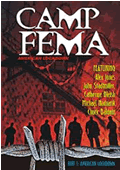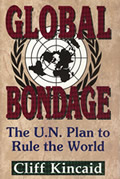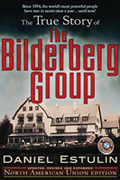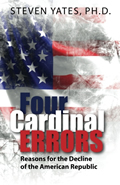"TAKING
THE RED PILL"
THE
REAL MATRIX
PART 9
By Professor
Steven Yates
June 14, 2014
NewsWithViews.com
The Globalization / Economic Development Matrix
“What is the Matrix? Control. The Matrix is a computer generated dream world, built to keep us under control, in order to change a human being into this” [holds up a common flashlight battery].”
“No! I don't believe it! It's not possible!”
“I didn't say it would be easy, Neo. I just said it would be the truth.”
~Morpheus & Neo, The Matrix
Iran had come a long way, although it still had a ways to go. A democratic election in 1951 had made Mohammed Mosaddegh Iran's Prime Minister. Mosadegh, a nationalist, began a series of land reforms. He believed the Iranian people should benefit from the development of resources on Iranian soil, the most important of which was oil. He had a great deal of popular support. Later that year, he signed legislation nationalizing the then-British owned oil industry.
To say this upset Anglo-American corporatists in smoke-filled rooms is putting it mildly. Efforts began in controlled media to portray Mosadegh as having fallen under the spell of communism. Threats followed. Mosadegh stood his ground. He was portrayed in said media as a “dictator.” On August 19, 1953, a coup masterminded by the CIA for the British MI6 deposed Mosadegh's government and put Reza Pahlavi, known as the Shah of Iran, back in power.
The coup was called Operation Ajax. One man did the most to mastermind it: Kermit Roosevelt (FDR's grandson). The Shah, who had been educated in the U.S., would restore Anglo-American corporatism. His government, which encouraged Western-style materialism, would brutalize political dissidents for the next quarter century, helping incubate Islamic radicalism.
Guatemalans had also elected a nationalist in the early 1950s, Jacobo Arbenz, who initiated land reforms. These would allow his own people to benefit from development instead of money leaving the country in corporate coffers. United Fruit Company, which had controlled the Guatemalan economy for decades, didn't care to have its supremacy challenged. The corporation launched the same ploy: Guatemala was in danger of going communist! The ploy worked again. In 1954, the world saw another U.S.-backed coup that deposed Arbenz and instilled someone more “cooperative.” That person happened to be Carlos Castillo Armas, another tyrant who imprisoned and tortured dissidents. United Fruit was back at the helm, and the phrase banana republic crept into the political lexicon.
It quickly became clear inside the smoke-filled rooms that actions of this sort were dangerous. They were too visible. Had the CIA's role in the Iranian coup been exposed at the time, it could have caused the U.S. government a lot of grief, especially in a Muslim world rising to consciousness of how its land and oil reserves were being plundered by British-American interests who took their profits out of the country.
Quietly, behind the scenes, corporatists devised a new strategy. Instead of sending in the CIA, they would work through private consultants—economic hit men (EHMs). Enter John Perkins. In his riveting book on the subject, he tells us that at first, they were actually called that. “Who would take it seriously?” he quotes his mentor. The idea sounds like the product of someone who has read too much Robert Ludlam. That was the point.
Perkins tells of the directed economic development of nations on multiple continents: Ecuador, Indonesia, Saudi Arabia, Venezuela, others. The corporatocracy—the aggregation of global corporations, sources of funding such as the International Monetary Fund (IMF) and the World Bank, and major governments such as that of the U.S. and Great Britain (he doesn't talk about the British much, an unfortunate lacuna)—learned subtlety. Instead of orchestrating a coup, a consulting firm contracted for the purpose would send in an EHM—the job Perkins tells us ashamedly he did for ten years.
The EHM's job: go into a small country and offer a newly elected popular leader enough money to make his eyes water: for himself and his family, and for a few elite families. The EHM will have developed—or more exactly, fabricated (something which, as Perkins explains, “econometrics” makes possible)—reports exaggerating the country's prospects for economic development. This would justify a huge loan from the IMF or the World Bank. The leader and his elite friends could keep enough for themselves to live in splendor; the rest would go to corporations who would build up infrastructure: roads and highways, bridges and dams, electrical and communications systems, airports, Western-style shopping malls, plush hotels and restaurants, etc.
Going along with the promise of huge sums of money was a thinly-veiled threat: play ball, or sooner or later you're going down!
The country would find itself with a huge debt it couldn't repay. That was the plan. The EHM would return. He would offer to have the debt refinanced in exchange for, e.g., selling resources (e.g., oil) dirt cheap, allowing a U.S. military base on its soil, voting with the U.S. at the UN, or—much later—signing a “free trade” agreement. The price tag: the leader serves the corporatocracy instead of his own. Indigenous peoples, that is, would not see tangible benefits, in the form of better health care, education, etc. Cooperation didn't erase the debt, after all, and the bulk of the country's resources would have to go to paying it down.
Some refused to be corrupted. Examples: Jaime Roldóz of Ecuador and Omar Torrijos of Panama. Both sought economic development that would improve the lot of their own people. Torrijos was a hero to Latin Americans because of his skillful negotiation of the Panama Canal Treaty. Both had won democratic elections, and had plenty of popular support.
This is when those Perkins calls the jackals go in. They plot an assassination. Both Roldóz and Torrijos died in plane crashes—clearly acts of sabotage—just two months apart in 1981. In the case of Panama, again someone seen as “more reasonable” replaced him: Manuel Noriega. Noriega was known to be corrupt, to be trafficking illegal drugs. As long as he cooperated, his handlers looked the other way. But when all is said and done, he was Panamanian and wearied of serving the bully to the north at the expense of his own. He began dragging his feet. This was a tactical mistake. His nose wasn't clean. Bush the Elder could label him a drug dealer. The controlled media piled on, calling him “dangerous” and “evil” and “a monster” (in Hollywood-saturated middle America, that one always works!). Bush felt authorized in sending in the military in to take him down.
Thus on December 20, 1989, the U.S military flattened Panama City, setting fire to large neighborhoods, killing what some estimate to have been three to five thousand innocent Panamanians: human beings whose only “crime” was living under a government that has ceased serving the corporatocracy. We don't have a precise body count, because U.S. troops kept the local press, the Red Cross, and other humanitarian organizations out of the area for three days. Noriega was flown to the U.S, put on trial for such charges as “racketeering” and “money laundering,” and has spent the rest of his life in prison, first in the U.S. and now in his native country.
Perkins interpreted the action in Panama as a sign that the EHM approach wasn't working, or at least wasn't working consistently enough. Too many “tin horn dictators” were refusing to serve corporatist masters. Plus, Bush the Elder was trying to overcome the infamous “wimp” image that suggested he wasn't fit to fill the shoes left by his popular predecessor, Ronald Reagan.
The jackals, moreover, don't always succeed. When they fail, invasion is the last resort. This appears to be what happened in the case of Iraq's Saddam Hussein. Hussein had been put in power in 1980 while media attention was riveted on the Iranian hostage crisis which ruined Jimmy Carter's presidency and helped Reagan's star rise. Perkins describes the plans the corporatocracy had for Hussein's oil-rich country, paralleling those which turned Saudi Arabia into a regional power, enabled the House of Saud to roll in cash, while resolving the OPEC-led embargo of the 1970s. Perkins describes this as the “Saudi Arabia Money-laundering Affair” (SAMA). “Money laundering,” you see, is legal when the corporatocracy does it.
But Hussein also stopped cooperating. This was bad news, not just because of Iraq's oil reserves but its strategic location. The Bush regime sought a means of cutting him down to size, and found it when he invaded Kuwait in 1990 thinking he had a “green light” from the U.S. via our own ambassador. Bush, however, responded with the Gulf War. He accused Hussein of “violating international law”—never mind his own destruction of Panama City just a year before. Hussein's army was no match for the international offensive Bush launched, of course; he was quickly driven out of Kuwait, and no longer the “wimp,” Bush's popularity soared! He left a hopefully chastened Saddam in power, however. But Saddam still wouldn't cooperate with the corporatocracy. The U.S. continued attempting to buy his cooperation by supporting Iraq's war with Iran that followed. He wouldn't yield.
There are claims that when the world obtained the euro in the 2000 decade, Saddam wanted to sell Iraqi oil in euros instead of dollars. This could have set off a chain reaction toppling the petrodollar system (oil must be bought and sold on world markets using dollars). This would have doomed the global empire, which depended not just on Middle East oil but on the fact that oil is sold in world markets in dollars. There are other theories. Let's not misunderstand. The man was no saint. He was a sociopathic tyrant, the sort of person the CIA tends to support when he does what he's told. But he refused to bow down before his presumed masters who had killed thousands of Iraqi civilians and turned his country into a war zone.
Doubtless knowing the dangers, he'd surrounded himself with top flight bodyguards and sending around lookalikes, which would make it difficult for a jackal to know he was targeting the right person. The result was the post-9/11 declaration of Iraq as an “axis of evil” nation, the March 19, 2003 invasion, and ensuing Iraq War which killed over 4,000 American troops, left thousands more maimed for life, killed or displaced tens of thousands more Iraqis, left the country in ruins, while costing U.S. taxpayers billions. In short, a disaster!
Perkins tells us that what compelled him to tell his story was 9/11. He'd started writing his book several times, stopping in response to pressure tactics and even bribes. An alternative energy company he'd founded after leaving the EHM business did very well; contacts and resources he needed just seemed to be there when he needed them. He attributed this to his silence about the EHM business. Finally he sold the business for a nice profit. The 9/11 attacks changed his mind about remaining silent. He had a story to tell, and the resources to tell it.
Clearly—for better or for worse—Perkins appears to accept the official narrative on those attacks. For sure, there are regions in the world where the U.S. isn't liked very much. This, perhaps, is the one thing that makes the official story at all credible. He's told his story at great risk. Obviously the corporatocracy hires some truly evil sociopaths—people able to kill without remorse. I've wondered if he wears bullet-proof clothing outdoors. I don't know.
This picture that emerges of the U.S. foreign policy of at least the past 64 years—that of the “desert of the real” outside the “real matrix”—is quite different from that of textbooks and controlled media propaganda. The latter present the U.S. as the “indispensable nation” bringing “liberal democracy” and “market capitalism” to the “third world,” while having contained “communism” until the Soviet Union “collapsed.”
Indigenous peoples see things very differently, of course. They see wrecked local economies, as corporations use trade liberalization to import goods and sell them at below-market rates, destroying indigenous trade (the equivalent of Mom and Pop being driven out of business when a Wal-Mart goes in). Their agricultural lands taken by the corporations, local peoples have a “choice” between working in the corporations' sweatshops for poverty wages or starving (just like Pop going from proud store owner to minimum-wage peon). They see ruined ecosystems, as they end up living and sometimes dying alongside rivers and lakes polluted from corporations dumping toxic waste that reaches the water table. The propaganda mill then says they are fortunate to be able to work in sweatshops: one dollar per day is better than zero dollars per day!
Indigenous peoples who launched protests against such practices found themselves labeled “communists” in line with the Western mainstream ideological “matrix.” This ideology divides the world into “capitalists”—those who profit from, participate in, support, or go along with the global corporatocracy—and “socialists” or “communists”—nationalists or populists who stand up for the rights of their own people to at least a portion of profits from their nations' own natural resources, or otherwise live as they see fit according to their traditional ways and be left alone.
Who shapes this ideology? Western economists have used this vocabulary since the days of Karl Marx, of course. Today, behind controlled media are six leviathan corporations, keyed to government, leviathan banks, and the debt-based system controlled by the Federal Reserve and supportive of globalization (the IMF, World Bank, etc.). Government has certainly done its part, via its well-paid economists pushing “free trade.”
Among the things that make this ideology so effective is the relative isolation of most Americans from the rest of the world. Most have never visited a foreign country in, e.g., Central or South America, much less lived in one. Their image of indigenous peoples has been shaped by pictures of mostly-unclothed “natives” in National Geographic. Most have never had to learn a foreign language. They have never sat down across a table from an Iraqi, Venezuelan, or a Chilean who lived under the Pinochet dictatorship that ran Chile from 1973 to 1990 and listened to what they have to say. Most gringos' sources of information are the above controlled media, which speaks of “tin horn dictators” and “unruly peasants” who “don't appreciate” what the “civilized world” is doing for them.
Making things worse is how education has declined in the U.S. I saw this personally, as an entire generation bought into the it's-morning-in-America foolishness that followed the Reagan election in 1980. So-called conservatives cheered that college kids had cut their hair, cleaned themselves up, were dressing nicely, and majoring in business instead of philosophy. As an aspiring university professor doing graduate work I saw the truth: many “hippies” of the '60s and '70s had read books and could discuss issues with at least some intelligence even if they didn't get everything right—not all of them took LSD. The “preppies” (their term for themselves) of the '80s could barely write coherent sentences. By 1987, the year I received my Ph.D., the average college student couldn't find Iraq on a map. And by the way, drug use didn't disappear from campuses in the 1980s.
That was before political correctness hit. That, of course, just pushed education the rest of the way off a cliff. But that's another story. Just to note: one reason we have over a trillion dollars in outstanding student loan debt is the prevailing illiteracy, especially financial illiteracy—among vulnerable high school students lured to college whether they should be there or not; it reflects the absense of real education as they take ridiculous “gender studies” courses, and then are transformed into debt-slaves when they graduate.
We are talking about preparing a controlled population for life plugged into the “real matrix.” Out in the “desert of the real,” outside the fantasy of Western economic and media propaganda including pseudo-intellectuals going on about the “inevitability of globalization”: on one side there is still the alliance of money-hungry corporations, power-hungry politicians and other government officials able to be bought, and sociopaths willing and able to take out refuseniks. On the other side are indigenous peoples—now including the U.S.'s own former middle class!—typically poor in resources, not well organized, and wishing only to live in traditional ways with their families, communities, religious beliefs, agrarian local economies, etc. We wonder, of course, about the origins of Arab Spring and other evidence of unrest in the world outside the American cultural bubble.
As this series continues we will underscore, where possible, the worldviews on collision course. Perkins entitled a central chapter of his book “American Republic versus Global Empire.” As I've stressed in previous articles, the U.S. was founded on a set of moral principles—principles rooted in the idea, however we cash it out, that moral and spiritual reality is not exhausted by physical or material reality or economic reality, and that individuals have the right to live as they see fit if they are not harming others. The result was a Constitutional republic. It wasn't perfect. But it was the best hope humanity had at the time.
The globalization of the corporatocracy is founded on materialism: the idea, ultimately, that nothing exists beyond the physical or material world, operating according to the laws of mechanics and economics, and that there are therefore no moral or spiritual principles beyond pleasure, mass consumption, and the pursuit of wealth and power. Materialism leads to the idea that those in power answer only to each other. Greed and corruption dominate: “Gekko-ism” (“greed … is good”).
This worldview is a wrecking ball of destruction. It has decimated cultures—including our own, little by little. Economics rises as a “science” the main purpose of which is to construct rationalizations (e.g., the “econometrics” Perkins mentions). Among the revelations of the “Fate of Empires” articles (here and here) were that the pursuit of money as an end in itself is dangerous. Unless controlled by a sound worldview, it turns on the civilization that gave rise to it and destroys it from within little by little. It sets a process in motion that has to expand and keep on expanding. It therefore tries to take over everything.
|
You arrive in a world where normalcy means knowing the price of everything and the value of nothing. A medium of exchange has come to circumscribe all our lives whether we subscribe to a materialist philosophy or not. Most people in advanced societies go to work helping CEOs get richer. We are told from childhood that this is having a good “work ethic,” although prosperity eludes us peons. We see no credible way out. This breeds cynicism and disillusionment—attitudes that undermine a people's incentive to change what ought to be changed. The irony is that long ago, money became electronic smoke and mirrors: itself part of the “real matrix.” In the “desert of the real,” this system is unsustainable in any reasonable sense of that term. We'll see this in the next installment.
Next: The Financialization Matrix.
Steven Yates has a doctorate in philosophy and currently lives in Santiago, Chile. He is the author of Four Cardinal Errors: Reasons for the Decline of the American Republic (Brush Fire Press International, 2011). He also owns an editing business, Final Draft Editing Service.
E-Mail: freeyourmindinsc@yahoo.com















 Share
This Article
Share
This Article






